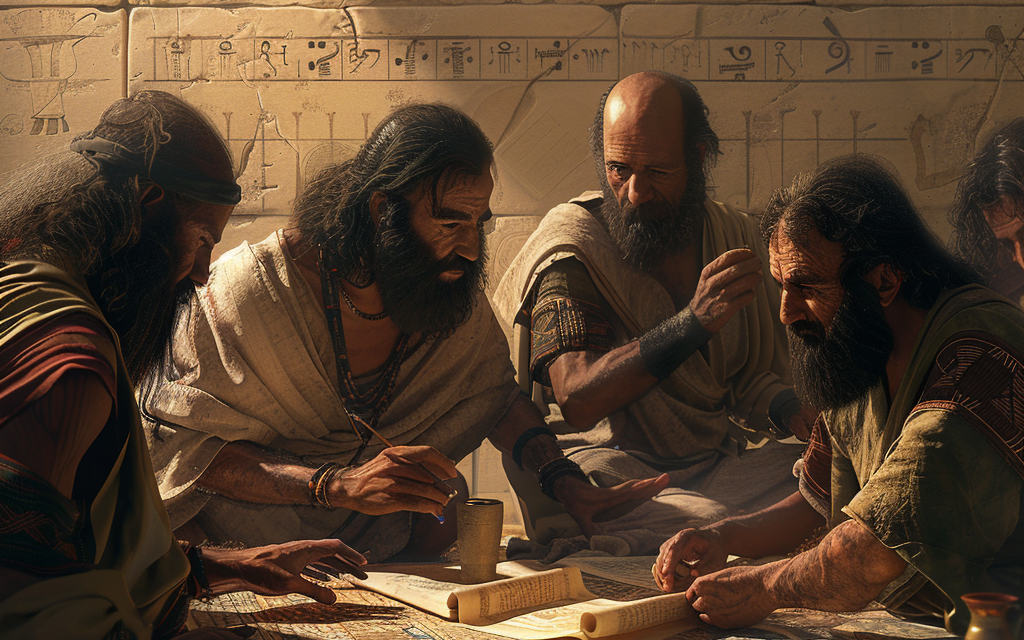Introduction
Imagine a world without numbers, where the concept of ‘zero’ is as alien as a diet without pizza. Hard to picture, right? That’s because mathematics is so ingrained in our everyday lives, from the alarm clocks that wake us up to the smartphones that keep us connected. Math isn’t just a subject in school; it’s the language of the universe, helping us describe everything from the architecture of a snail’s shell to the trajectories of planets. But here’s a brain teaser for you: was math invented by humans to make sense of the world around us, or did we simply discover these universal truths that were always there, waiting to be uncovered like hidden treasures? Journey with us as we unravel the tapestry of mathematics, exploring its origins and how it became the bedrock of human knowledge.
The Dawn of Mathematical Thought
Long before the ancient philosophers pondered the mysteries of the universe, early humans were already applying the basics of math. Imagine early humans, not unlike ourselves, trying to figure out if they had enough berries to last the winter or enough people to fend off a saber-toothed tiger. They recognized patterns in the stars, seasons, and even in the rhythm of their own heartbeats. This wasn’t math for math’s sake; it was survival 101. The development of numerals was humanity’s first step towards civilization, transforming ‘many berries’ and ‘many more berries’ into something countable, like ‘one, two, three…’ These early counting systems were the seeds from which the giant tree of mathematics would grow, nurtured by the civilizations of Mesopotamia and Egypt.
The Cradle of Civilization: Mathematics in Ancient Cultures
- Mesopotamia and Egypt
In the fertile crescent of Mesopotamia, where writing first flourished, so too did mathematics. The Sumerians, with their pioneering cuneiform script, gave us the first written evidence of math, solving problems that would make most modern-day students sweat. Meanwhile, the Egyptians were not far behind, using geometry to turn the chaos of the Nile’s floods into the orderly rows of pyramids and fields. They developed a system of numerals that made accountants out of architects and tax collectors out of pharaohs.
- Ancient Greece
If Mesopotamia and Egypt laid the groundwork, Ancient Greece built the penthouse. Characters like Pythagoras found harmony in numbers, while Euclid made geometry the talk of the town. Archimedes, possibly the first person to shout ‘Eureka!’ in a bathtub, showed us the power of mathematical insight. These were the rock stars of ancient math, turning abstract thoughts into theorems and principles that still form the foundation of modern mathematics. Their work wasn’t just about solving practical problems; it was a quest to understand the principles that govern the cosmos.
The Global Tapestry of Mathematical Development
- India
In the lush landscapes of India, mathematicians treated numbers with the reverence of deities, birthing concepts that would forever change the mathematical world. The concept of zero, a true game-changer, emerged from these intellectual endeavors, giving us a symbol for nothing that paradoxically became everything in calculations. The decimal system, another Indian marvel, streamlined computations, making trade and astronomy a tad less headache-inducing. And let’s not forget about early trigonometry, which allowed Indian astronomers to chart celestial paths long before GPS made it a piece of cake.
- China
Meanwhile, in China, the abacus rattled away in marketplaces and scholarly halls, simplifying calculations in ways that would make modern-day Excel users envious. Chinese contributions to algebra and geometry were no less impressive, laying down the groundwork for future mathematical exploration. Their meticulous work in measuring the Earth and calculating astronomical events showed a harmony between mathematics and the natural world.
- Islamic Golden Age
The Islamic Golden Age was a renaissance of knowledge, where scholars from Baghdad to Córdoba seized Greek mathematical texts, infusing them with new life. Algebra found its formal voice in the works of Al-Khwarizmi, and the torch of Greek geometry was carried and expanded upon. These scholars built an intellectual bridge between the ancient and medieval worlds, ensuring that the flame of mathematical inquiry burned bright through the dark ages.
The Renaissance and the Age of Enlightenment
The Renaissance was not just about art flourishing in Europe; it was a period when mathematical knowledge, too, found fertile ground to grow. This era saw the spread of mathematical texts, now printed and accessible, fueling an explosion of knowledge. Then came Newton and Leibniz, two giants on whose shoulders we stand, who independently developed calculus. This breakthrough allowed humanity to calculate motion and change, unlocking secrets of the universe that had puzzled philosophers for centuries.
The Modern Era: Formalization and Expansion
The 19th and 20th centuries were a period of introspection for mathematics, focusing on its very foundations. Debates raged over the bedrock of mathematics, leading to the formalization of its structures. This era also saw the branching out of mathematics into fields like topology, which twists and stretches our understanding of space, and abstract algebra, where operations dance in theoretical realms. The rise of computing, too, owes a debt to mathematical pioneers who laid the groundwork for binary code and algorithms.
Mathematics in the Information Age
As we navigate the Information Age, mathematics has proven to be the unsung hero behind the scenes. From the development of computers and the internet to the algorithms that power our digital lives, mathematics is the silent partner in innovation. Its applications now extend far beyond traditional boundaries, influencing everything from how we understand economic trends to modeling social behaviors and even unlocking the secrets of the universe.
In every byte of data and in every pixel on the screen, there is a piece of mathematics at work, demonstrating that this ancient language of numbers and equations is more relevant today than ever. As we look to the future, the journey of mathematics continues, promising new discoveries and innovations that will, no doubt, continue to shape our world in ways we can only imagine.
The Nature of Mathematical Discovery
- Is Mathematics Invented or Discovered?
Ah, the age-old debate that could make even the calmest mathematician’s compass spin: Is mathematics an invention of the human mind, or is it the universe’s language, patiently waiting to be uncovered? Some argue that mathematics is purely a construct, invented to make sense of our surroundings. Yet, others see it as the discovery of fundamental truths that exist whether we’re here to calculate them or not. Imagine if pi decided to change its value on weekends, or if triangles suddenly voted to have five sides – chaos would ensue. This suggests there might just be something universal and intrinsic about mathematical truths.
- Mathematics: The Universal Language
Philosophically speaking, many have waxed lyrical about mathematics being the language with which the universe is written. Galileo once said, “Mathematics is the language in which God has written the universe.” Whether you’re measuring the distance to the next star or figuring out if you have enough coffee for the week, math is the silent narrator of our lives, describing the world in terms beyond mere words. It’s like the universe has its own programming code, and math is our way of hacking into it to understand how everything works.
Challenges and the Future of Mathematics
- Current Challenges in Mathematical Research
Mathematics today faces challenges that would make even Pythagoras scratch his head. From the Riemann Hypothesis to P vs NP, unsolved problems abound, tantalizing mathematicians with their complexity. Then there’s computational complexity, where we know the problems but can’t solve them quickly enough with our current tools – like trying to eat soup with a fork. These challenges push the boundaries of what we know, driving innovation and discovery.
- The Future of Mathematics: Beyond the Horizon
As we gaze into the mathematical crystal ball, the future is as exciting as a prime number party. Mathematics stands at the forefront of revolutions in technology, quantum computing, and artificial intelligence. Imagine a world where quantum computers solve millennia-old problems in the blink of an eye, or AI that can model the universe’s mysteries. Math is not just about numbers and equations; it’s the engine powering the future of human knowledge and technology.
The Endless Journey of Mathematical Discovery
Mathematics is more than just a subject taught in school; it’s the backbone of civilization, a bridge between the known and the unknown. Its universal nature underscores its integral role in human advancement, from the earliest counting systems to the algorithms driving tomorrow’s innovations. As we continue on this journey of discovery, one thing is clear: the potential of mathematics is as limitless as the universe itself. Whether invented or discovered, mathematics remains humanity’s most enduring and powerful tool, a testament to our relentless pursuit of understanding and progress.





